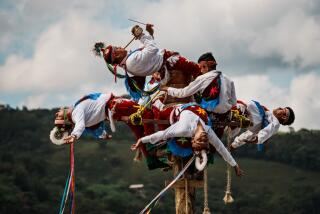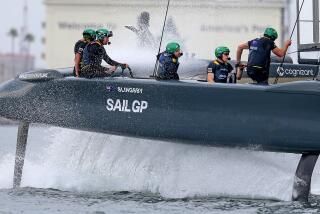Soaring to New Heights : Aviation: Sailplanes, a twist on gliders, allow people who arenât in a hurry--often older folks--to indulge both their love of flying and thirst for adventure.
Bumping around in a plane without an engine doesnât sound like the greatest cure for open-heart surgery, but for Hal Lord, flying one of the sleek planes was just the treatment he needed.
Lord didnât start flying a sailplane, a type of glider, until he was 65, and he wasnât about to let quadruple bypass surgery ground him. Now at the ripe old age of 69, Lord insists that flying has kept him young and vows that heâll keep at it until âthey put me under.â
âIf you get to be 60 and sit on your butt all the time, you arenât going to be around for long,â said Lord, a retired Navy pilot who proudly wears a pin that reads âRetirement is a full-time job.â
Lord isnât alone among people his age who enjoy venturing into the air strapped to nothing more than a sailplaneâs seat. In fact, about 70% of the 39 flying members of the Orange County Soaring Assn. are older than 30, and 10 or so are older than 60.
Take, for instance, Hank Faeth, OCSAâs oldest member at 69 years and 10 months. Heâs been flying motorized airplanes for more than 50 years and sailplanes for about 14 years. Or Ralph Fuller, a 30-year sailplane pilot who started training other pilots with the Air Forceâs Auxiliary Civil Air Patrol in Hawaii in 1961.
âThere tend to be more older people in the club,â said Fuller, 69, who is now an OCSA flight instructor. âYounger people are always in a hurry to get someplace.â
The fast life is not what these pilots experience. Adventure, yes. Challenge, definitely. But they do not live for the quickest route between two points. Although they can fly upward of 140 m.p.h., the route they take is anything but direct.
The 1,000-pound planes get airborne by being towed behind motorized planes. Once high enough in the air, the glider pilot unhooks the sailplaneâs tow line and soars about, searching for shifting air currents. The planes stay aloft by riding warm patches of air called thermals. Heat bubbles off the desert--like bubbles in a pot of boiling water--and lifts the plane, often to heights of 20,000 or 30,000 feet.
One recent Saturday, with his high-performance sailplane quietly hovering at about 6,500 feet, Fuller exclaimed almost with disbelief, âHereâs this thing with no engine and two people in it going up. Thatâs the exhilarating part.â
When one warm-air lift dies down, the pilot must soar in search of another. Veteran fliers can see the currents of moving air--all but invisible to the untrained eye--and maneuver their planes toward them. Typical flights last about an hour, but seasoned sailplane pilots can find enough summer thermals to fly for hours.
âGlider pilots are always working with Mother Nature,â Fuller said. âIn power planes, you go from A to B. Thereâs no sport in that. This is pure sport. And on the right day, you can stay up all day.â
A âright dayâ is marked by typical Southern California summer weather, with high afternoon temperatures in contrast with cool temperatures from the night before. The drastic change in temperature creates a lot of relative heat and the strong thermals that give sailplanes their lift.
Shooting Straight Up
Ideal conditions are found in the nearby desert areas, Fuller said, because the desert floor reflects heat and produces strong thermals. In addition to the thermals, a natural phenomenon called a shearline makes flying in certain parts of Southern California different from almost anywhere else in the world.
Near Perris Valley Airport in Riverside County, where OCSA members do most of their flying, a shearline forms as warm desert winds ride over the cool marine air that gets trapped between two mountain ranges, Fuller said. The warm winds hit the cool air and tend to shoot straight up, lifting the smart sailplane pilot to incredible heights for miles.
The cool marine air carries smog with it, in contrast to the clear desert currents, making it easier for pilots to spot and utilize shearlines.
âYouâve now discovered the only good thing smog is used for,â Faeth said.
Every flight is different, depending on the amount of turbulence and lift that the pilot finds. Some flights are quiet, have little lift and can last 30 minutes. Others are rougher, feature lots of lift and can last for hours. This particular Saturday, Lord had just returned from a three-hour flight.
It isnât difficult to understand why the pilots seek to stay up so long. Once the sailplanes are flying on their own, the only noise is the sound of air washing over the plexiglass-covered cockpit or through the 3-by-3-inch vents that provide air conditioning.
More Than 50 Flights
âI love the feeling of your stomach being taken away and the earth rotating around you,â OCSA member Meggan Clark said. âWhen you close your eyes and lay back, it feels like the bottom is dropping out of the plane.â
At one month shy of her 13th birthday, Clark is OCSAâs youngest member, proving that the young can be young at heart too.
âI came down from my first flight and Iâm like, âYeah, I like this a lot. Can I join the club too?â â Clark remembers. She was 11 when she took her first ride and has been flying for almost two years now. She has more than 50 flights to her credit and is ready to fly by herself, but Federal Aviation Administration laws that govern sailplaning say she must be 14 to solo.
Whatever the age, the spark in each of these fliersâ eyes is the same--a desire for adventure mixed with a love of flying. And none of them ever expect to be cured of it.
For 30-year-old Oscar Alonso of Westminster, sailplaning was one of those things he wanted to try before he got too old.
âThe day after my first flight, I said, âHey, this is for me,â â Alonso said. Heâs been flying now for three years and edits OCSAâs monthly newsletter. âTo fly, youâve got to have some time and some money,â he said. âWhen you are younger, you want to get ahead. But I had all these things I wanted to do before I got old.â
OCSA formed in 1959. Since then, the club has grown to more than 120 members, most supporting the sport but not actively flying. One-day OCSA memberships, which include an introductory flight of about 30 minutes, cost $40. For those interested in learning how to fly the planes themselves, club dues, National Soaring Society of America dues, insurance and monthly flying fees can reach $1,500.
The club is the most economical way to learn to fly, members say, because the only per-flight expense is the tow charge--usually about $16. To fly privately with a commercial pilot, the flier must pay for the tow, the glider rental and the instructorâs time.
âAnd itâs safe,â Alonso said. âThereâs nothing to fail--no lubricant, no fuel to go out. The only thing that is unsafe about sailplaning is hitting another aircraft in the air. Everything is a risk in life--this not excluded. But if you had to pick something safe, this is the safest.â
For some of the fliers, now that theyâve started sailplaning, things will never be the same.
âThe whole game of soaring is loitering in the up-going air and hauling . . . in the down-going air,â said 59-year-old Scott MacIndoe, a power pilot and five-year sailplane pilot from Tustin. âI kept riding by glider ports saying, âIâve got to try one of those.â I did, and I got hooked. Now the only purpose for a plane with an engine is to get a glider off the ground.â
More to Read
Sign up for The Wild
Weâll help you find the best places to hike, bike and run, as well as the perfect silent spots for meditation and yoga.
You may occasionally receive promotional content from the Los Angeles Times.






